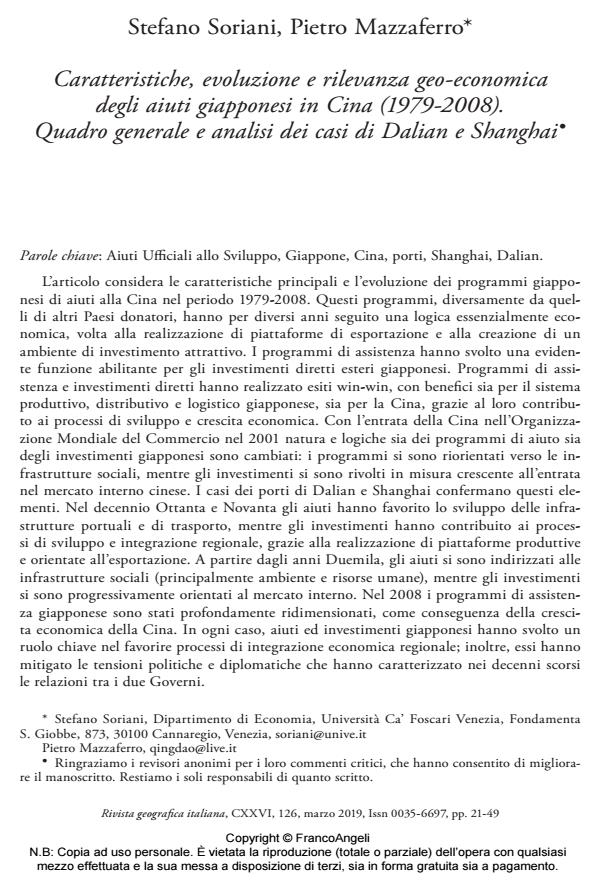Caratteristiche, evoluzione e rilevanza geo-economica degli aiuti giapponesi in Cina (1979-2008). Quadro generale e analisi dei casi di Dalian e Shanghai
Titolo Rivista RIVISTA GEOGRAFICA ITALIANA
Autori/Curatori Stefano Soriani, Pietro Mazzaferro
Anno di pubblicazione 2019 Fascicolo 2019/1
Lingua Italiano Numero pagine 29 P. 21-49 Dimensione file 201 KB
DOI 10.3280/RGI2019-001002
Il DOI è il codice a barre della proprietà intellettuale: per saperne di più
clicca qui
Qui sotto puoi vedere in anteprima la prima pagina di questo articolo.
Se questo articolo ti interessa, lo puoi acquistare (e scaricare in formato pdf) seguendo le facili indicazioni per acquistare il download credit. Acquista Download Credits per scaricare questo Articolo in formato PDF

FrancoAngeli è membro della Publishers International Linking Association, Inc (PILA)associazione indipendente e non profit per facilitare (attraverso i servizi tecnologici implementati da CrossRef.org) l’accesso degli studiosi ai contenuti digitali nelle pubblicazioni professionali e scientifiche
L’articolo considera le caratteristiche principali e l’evoluzione dei programmi giapponesi di aiuti alla Cina nel periodo 1979-2008. Questi programmi, diversamente da quelli di altri Paesi donatori, hanno per diversi anni seguito una logica essenzialmente economica, volta alla realizzazione di piattaforme di esportazione e alla creazione di un ambiente di investimento attrattivo. I programmi di assistenza hanno svolto una evidente funzione abilitante per gli investimenti diretti esteri giapponesi. Programmi di assistenza e investimenti diretti hanno realizzato esiti win-win, con benefici sia per il sistema produttivo, distributivo e logistico giapponese, sia per la Cina, grazie al loro contributo ai processi di sviluppo e crescita economica. Con l’entrata della Cina nell’Organizza¬zione Mondiale del Commercio nel 2001 natura e logiche sia dei programmi di aiuto sia degli investimenti giapponesi sono cambiati: i programmi si sono riorientati verso le infrastrutture sociali, mentre gli investimenti si sono rivolti in misura crescente all’entrata nel mercato interno cinese. I casi dei porti di Dalian e Shanghai confermano questi ele-menti. Nel decennio Ottanta e Novanta gli aiuti hanno favorito lo sviluppo delle infrastrutture portuali e di trasporto, mentre gli investimenti hanno contribuito ai processi di sviluppo e integrazione regionale, grazie alla realizzazione di piattaforme produttive e orientate all’esportazione. A partire dagli anni Duemila, gli aiuti si sono indirizzati alle infrastrutture sociali (principalmente ambiente e risorse umane), mentre gli investimenti si sono progressivamente orientati al mercato interno. Nel 2008 i programmi di assistenza giapponese sono stati profondamente ridimensionati, come conseguenza della crescita economica della Cina. In ogni caso, aiuti ed investimenti giapponesi hanno svolto un ruolo chiave nel favorire processi di integrazione economica regionale; inoltre, essi hanno mitigato le tensioni politiche e diplomatiche che hanno caratterizzato nei decenni scorsi le relazioni tra i due Governi.
Parole chiave:Aiuti Ufficiali allo Sviluppo, Giappone, Cina, porti, Shanghai, Dalian
- Changing Images? Italian Twitter Discourse on China and the United States during the First Wave of COVID-19 Frank Maracchione, Giulia Sciorati, Claudia Roberta Combei, in The International Spectator /2024 pp.77
DOI: 10.1080/03932729.2023.2299452
Stefano Soriani, Pietro Mazzaferro, Caratteristiche, evoluzione e rilevanza geo-economica degli aiuti giapponesi in Cina (1979-2008). Quadro generale e analisi dei casi di Dalian e Shanghai in "RIVISTA GEOGRAFICA ITALIANA" 1/2019, pp 21-49, DOI: 10.3280/RGI2019-001002